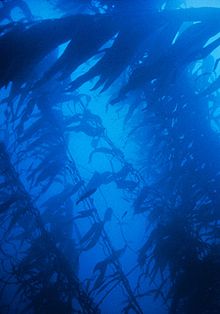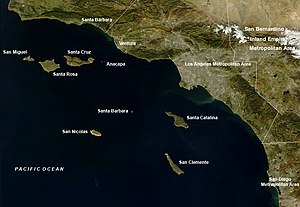Channel Islands (California)
| Channel Islands | ||
|---|---|---|
| Satellite image of the Channel Islands | ||
| Waters | Pacific Ocean | |
| Geographical location | 33 ° 35 ′ N , 119 ° 15 ′ W | |
|
|
||
| Number of islands | 8th | |
| Main island | Santa Catalina | |
| Total land area | 908.79 km² | |
| Residents | 3703 | |
| Channel Islands map | ||
The Channel Islands of California ( English Channel Islands of California ), also Santa Barbara Islands , are a group of eight islands off the coast of southern California . The island's waters are known for their abundance of marine life. The name of the archipelago refers to the Santa Barbara Channel , which runs north between the islands and the mainland.
geography
The eight islands consist of four islands that are geographically more related to the coastal area of Santa Barbara and Ventura and four islands that are geographically more related to the coastal area of Los Angeles:
| island | Area (km 2 ) |
Population ( Census 2000 ) |
county | summit |
Height m |
|||
|---|---|---|---|---|---|---|---|---|
| Northern Islands | ||||||||
| Anacapa | 2.95 | 3 | Ventura | Summit Peak | 283 | |||
| San Miguel | 37.74 | - | Santa Barbara | San Miguel Hill | 253 | |||
| Santa Cruz | 249.95 | 2 | Santa Barbara | Devils Peak | 747+ | |||
| Santa Rosa | 215.27 | 2 | Santa Barbara | Soledad Peak | 484 | |||
| Southern Islands | ||||||||
| San Clemente | 147.13 | 200 1) | los Angeles | Vista Point | 599 | |||
| San Nicolas | 58.93 | 300 1) | Ventura | unnamed | 276 | |||
| Santa Barbara | 2.63 | - | Santa Barbara | Signal Hill | 193 | |||
| Santa Catalina | 194.19 | 3696 | los Angeles | Mount Orizaba | 648 | |||
| Channel Islands | 908.79 | 3703 | Devils Peak | 747+ | ||||
|
1) Navy facilities, military personnel and civilian employees These values are not included in the total line |
||||||||
Santa Catalina is the only one of the islands that is permanently inhabited. San Nicolas and San Clemente are restricted areas controlled by the US Navy .
National park and marine reserve
San Miguel, Santa Rosa, Santa Cruz, Anacapa, and Santa Barbara together make up the Channel Islands National Park , to which tourist access is restricted.


The Channel Islands are home to the island gray fox , an endemic species of fox that is one of the smallest fox species in the world. This species developed from the North American gray fox and is a typical form of island dwarfing . About 30,000 to 12,000 years ago, another example of island dwarfing lived on the Channel Islands of California, the dwarf mammoth ( Mammuthus exilis ), an extinct species from the family Elephants with a shoulder height of 1.20 to 1.80 meters.
The surrounding seas are also protected and form the " National Marine Sanctuary of the Channel Islands" ( Channel Islands National Marine Sanctuary ). It is one of the most biodiverse marine areas in the world. The large kelp forests are home to over 1000 different species. In addition to seaweed , these include various types of plankton , mussels , crabs , sea slugs , seahorses , wrasse , perch , rays , sharks , sea urchins , octopuses , starfish , anemones and sponges . This biodiversity makes the Channel Islands National Marine Sanctuary a prime location for cold water dives.
The abundance of fish in the area favors the occurrence of large whales as well as the colonies of the four seal species Northern elephant seal , California sea lion , Steller sea lion and Northern fur seal .
history
The earliest human settlement has been dated between 13,000 and 11,300 Before Present (defined as "before 1950"). From here a further settlement of the central Andes started about 4,200 years ago.
Web links
- Channel Islands National Park (English)
Individual evidence
- ↑ a b Dive The Channel Islands California (English), Aquaviews and LeisurePro, accessed June 15, 2011
- ↑ Torben C. Rick, Jon M. Erlandson: Kelp Forests, Coastal Migrations, and the Younger Dryas: Late Pleistocene and Earliest Holocene Human Settlement, Subsistence, and Ecology on California's Channel Islands , in: Metin I Eren (ed.): Hunter -Gatherer Behavior. Human Response during the Younger Dryas, Left Coast Press 2012, pp. 79–110, here: p. 81.
- ↑ Cosimo Posth, Nathan Nakatsuka, Iosif Lazaridis, Pontus Skoglund, Swapan Mallick, Thiseas C. Lamnidis, Nadin Rohland, Kathrin Nägele, Nicole Adamski, Emilie Bertolini, Nasreen Broomandkhoshbacht, Alan Cooper, Brendan J. Culleton, Tiago Ferraz, Matthew Ferry, Anja Furtwängler, Wolfgang Haak, Kelly Harkins, Thomas K. Harper, Tábita Hünemeier, Ann Marie Lawson, Bastien Llamas, Megan Michel, Elizabeth Nelson, Jonas Oppenheimer, Nick Patterson, Stephan Schiffels, Jakob Sedig Kristin Stewardson, Sahra Talamo, Chuan-Chao Wang, Jean-Jacques Hublin, Mark Hubbe, Katerina Harvati, Amalia Nuevo Delaunay, Judith Beier, Michael Francken, Peter Kaulicke, Hugo Reyes-Centeno, Kurt Rademaker, Willa R. Trask, Mark Robinson, Said M. Gutierrez, Keith M. Prufer, Domingo C. Salazar-García, Eliane N. Chim, Lisiane Müller Plumm Gomes, Marcony L. Alves, Andersen Liryo, Mariana Inglez, Rodrigo E. Oliveira, Danilo V. Bernardo, Alberto Barioni, Veronica Wesolowski, Nahuel A. Scheifler , Mario A. Rivera, Claudia R Plens, Pablo G. Messineo, Levy Figuti, Daniel Corach, Clara Scabuzzo, Sabine Eggers, Paulo DeBlasis, Markus Reindel, César Méndez, Gustavo Politis, Elsa Tomasto-Cagigao, Douglas J. Kennett, André Strauss, Lars Fehren-Schmitz, Johannes Krause, David Reich: Reconstructing the deep population history of Central and South America . In: Cell , November 2018, doi : 10.1016 / j.cell.2018.10.027 , ( PDF ).



